 [Reminded by a news story that we’ve reached the 20th anniversary of the death of Princess Diana, I recalled that I’d written something about it a few years later, which I published in August 2000 in a bi-weekly column I then ran in a local giveaway newspaper, the Star-Reporter chain, which had a circulation of about 60,000 here on Staten Island. Subsequently I put it online in a section of The Nearby Café devoted to life here in “the forgotten borough.”
[Reminded by a news story that we’ve reached the 20th anniversary of the death of Princess Diana, I recalled that I’d written something about it a few years later, which I published in August 2000 in a bi-weekly column I then ran in a local giveaway newspaper, the Star-Reporter chain, which had a circulation of about 60,000 here on Staten Island. Subsequently I put it online in a section of The Nearby Café devoted to life here in “the forgotten borough.”
On the assumption that few readers of this blog have drilled down into that archive, I’m republishing it here, with a few minor revisions. Part 2 appears below; click here for Part 1. Part 3 will appear shortly.― A. D. C.]
•
Public Tolerance and the Picture Press
Celebrity-mourning appears to enjoy an extremely short half-life, if we gauge it by the rapid decline in commemorative oomph of public “outpourings of grief” over the 1997 death of Princess Diana and the 1999 demise of John F. Kennedy, Jr. The muted and minor attention paid to them on their anniversaries this year suggests an emotional involvement with these figures on the part of the presumably deeply bereaved public (I’m not speaking of their families, friends, and loved ones) that’s roughly equivalent to affection for a house pet. Which, perhaps, accurately represents the relationship between celebrities and their fans.
As the cameras of the picture press turn, in such circumstances, from one set of media stars (the celebrities) to another (their adoring public), we have the opportunity to consider the dynamic between the picture press, the individuals that system singles out for ongoing attention, and the audience for that imagery. This industry-driven ecosystem, a twentieth-century phenomenon, constitutes a perfect example of the creation of demand in a market economy.
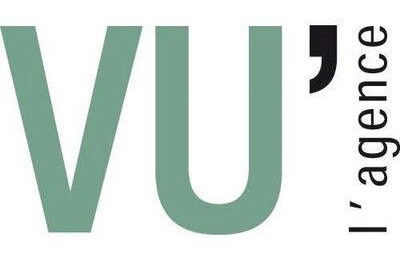 To begin with, let’s note the speciousness of the repeated claim by the photographers, picture editors, and publishers that they’re “only giving the public what it wants.” Alain Bizot, of the French picture agency VU, goes even a step further with this nonsense: “It is not the photographers but the public that has created this market,” he said a few days after the accident that caused Diana’s death.
To begin with, let’s note the speciousness of the repeated claim by the photographers, picture editors, and publishers that they’re “only giving the public what it wants.” Alain Bizot, of the French picture agency VU, goes even a step further with this nonsense: “It is not the photographers but the public that has created this market,” he said a few days after the accident that caused Diana’s death.
Assuming that he was translated accurately, Bizot is either remarkably ignorant or a willful liar. To constitute a market — that is, to be a part of it — is not to create that market. Aside from the production, sale and purchase for souvenir purposes of formal, consensually made studio portraits of politicians, actresses and other public figures that began circa 1860, we have no historical evidence of any traffic in or popular demand for unposed and non-consensual images of people until their presentation in the popular press commenced in the early decades of this century, instigated not by popular request but by enterprising photographers, picture editors, and publishers of periodicals.
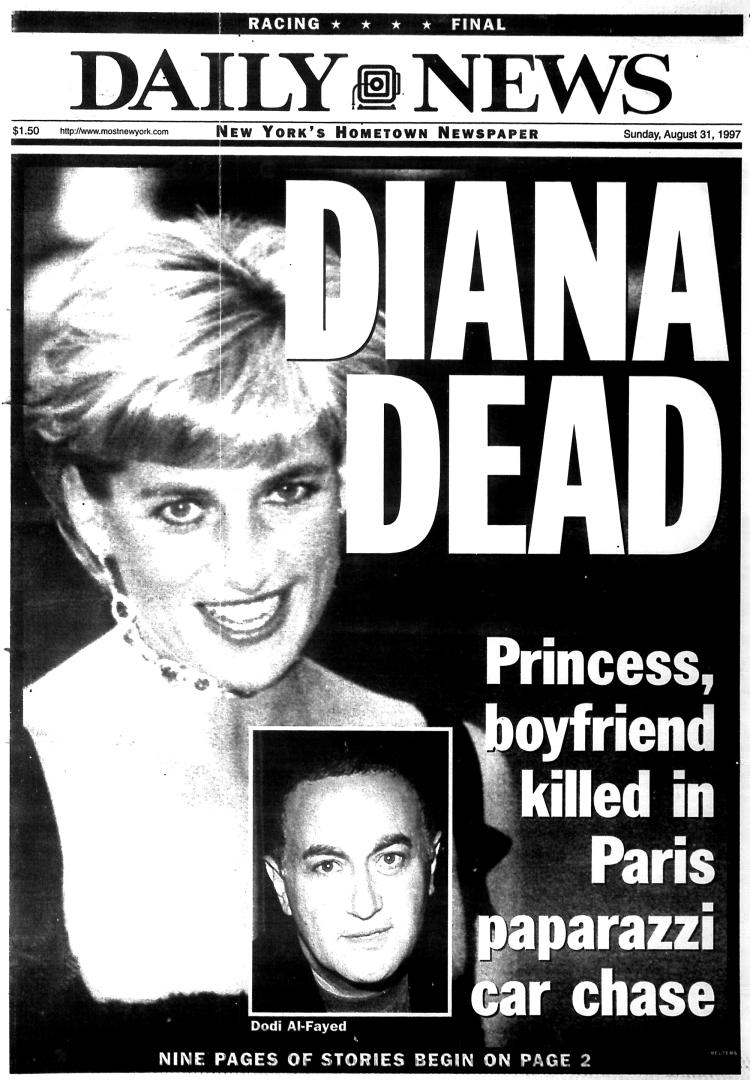
“Diana Dead,” NY Daily News, 8-31-97
So, while the public appears to be thoughtfully considering its own role in this ecology at last, this is not a chicken-and-egg situation. That a public appetite for and a habituation to such images developed gradually upon their introduction does not implicate everyone equally in the origins of this novelty. Like the capacity for addiction, curiosity about others and the inclination to gossip may be innate in most of us. But that disposition, in and of itself, does not make us all equally complicitous in the actions of those who choose to exploit that tendency for profit. Nor does it exculpate anyone from identifiable excesses, virtually all of which are committed in this case by the profiteers and not by their market.
Furthermore, the blanket notion that all forms of press photography serve either a public “need to know” or a public “right to know” is surely open to debate. And, in any case, neither of those is synonymous with the desire to know, which is the basis for most paparazzi imagery. A public appetite represents a “need” only in the emotional sense, and it is the task of responsible government to control unchecked and irresponsible impulse that affects the well-being of others.
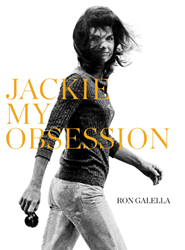
Ron Galella, “Jackie My Obsession” (2012), cover
Does any public have either the need or the right to know which actor had lunch with who, or that Fergie let someone suck her toes by a private pool, or that Jackie O. bathed topless on Gnossos, or that you or I kissed our lovers during a post-work stroll in midtown? Are you in fact “in public” when you’re inside your car with the windows rolled up, or behind the chain-link in your back garden, or standing inside your house looking out the window?
I can think of no surreptitiously made photos from the tabloid press that have provided information of any importance whatsoever in our political life. The few images in this country’s recent history that have made some difference in that regard while bordering on tabloid style — Ed Muskie crying at the podium, Gary Hart defiantly bouncing a blonde tootsie on his knee — came out of situations that were either officially public or at least consensual in regard to press presence and reporting.
Moreover, the wilding behavior of paparazzi generally merits discussion. This is almost exclusively a male sport; this branch of the press corps has few women members. (Its name is an Italianate pluralization of the name Paparazzo, a fictitious character in Federico Fellini’s “La Dolce Vita” based on a famous celebrity-hunting Italian press photographer of the 1950s.) Its practitioners treat it as a blood sport, as any interview with any of them makes appallingly clear. Despite the frequent claims that they’re “just doing their job,” most of them work freelance, which means they don’t have a job, but rather an occupation. Most are not even on retainer or assignment from specific periodicals; hence they are independent entrepreneurs operating purely autonomously and without any editorial directive or supervision.
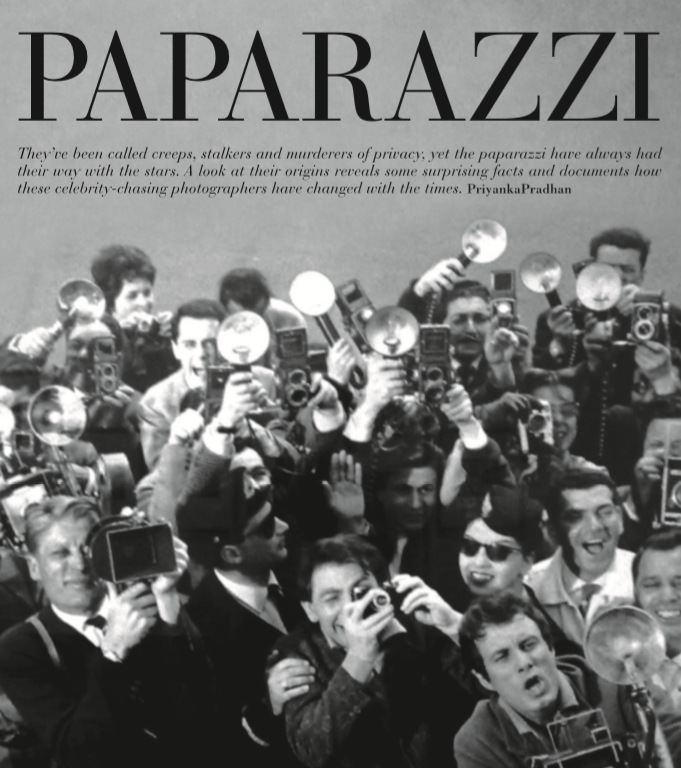
“La Dolce Vita,” still, in layout for Sorbet Magazine, Issue 4 (May 2014)
Their rude, abusive, bullying physical behavior — shouting and demanding attention, crowding around the subject in groups, actually touching the subject in many cases, invading personal space, sneaking into private events, disregarding the subject’s express wishes — certainly constitutes a form of stalking; with the photographs themselves as clear evidence, it is surely prosecutable under the stalking laws. And their “No means yes” rationales and enforcing on their subjects their uncontrolled lust for non-consensual intimacy strikes me as a direct analogue to rape, and needs to be considered in that light.
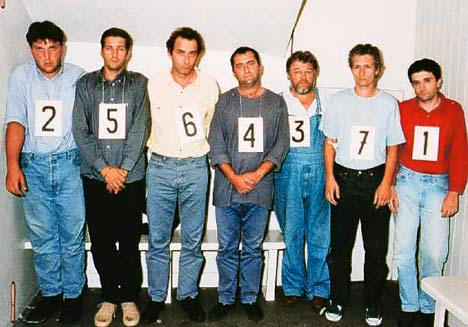
Paparazzi arrested after the crash (l-r): Romuald Rat, Serge Arnal, Jacques Langevin, Nikolai Arsov, Laslo Veres, and Christian Martinez, and motorcyclist Stephane Darmon. Mugshot courtesy French police.
Though most of the photographers involved in that last, fateful Di-hunt were French, and French law does not proscribe their photographing her per se, it does prevent the publication of such images anywhere in France. Privacy in public places is a legally established right in that country; excepting images made of public figures at public events, it’s a rare picture of someone that is published there without the subject’s consent. Yet no one I know of accuses the French of anti-democratic tendencies or a failure to make vital information available on the basis of these laws, and I’ve seen no outpouring from their colleagues elsewhere of indignation over these laws and support for the poor, oppressed French press photographers forced to work under these cruel and unjust strictures.
Which means that the French — who have a reasonably keen nose for censorship, and a much more respectable record than ours in support of freedom of expression — do not see such elementary protections as censorious, at least not to a degree that overrides the greater good of allowing people both celebrated and unknown to go about their business in peace. Photos of the stars in the limelight of the Cannes Film Festival, yes; pictures of them through the fences of their homes, no. Moreover, these protections extend to all, not merely the rich and famous. Perhaps the French model can serve as premise for the emergent dialogue over photographers’ rights versus the rights of their subjects.

Walker Evans, “Many Are Called” (1966), cover
Some will object that enacting of such laws will inhibit not only the photography wing of the press corps but also many creative photographers as well. They will point to such acclaimed bodies of photographic work as Walker Evans’s Many Are Called, a series of surreptitiously made portraits of anonymous New York City subway riders, noting that privacy laws such as those of France would have prevented publication of those images at least until their subjects had died, and that the history of photography would be the poorer without them. I’ll grant both points and acknowledge to boot that I love those studies of lonesome, indrawn faces. But I’ll also state that I’d have no problem with legislation that would have forced Evans to wait fifty years before publishing them. The enrichment of the medium of photography at the expense of individual rights does not constitute a deal I’m ready to cut.
(Part 1 I 2)
•
 Special offer: If you want me to either continue pursuing a particular subject or give you a break and (for one post) write on a topic — my choice — other than the current main story, make a donation of $50 via the PayPal widget below, indicating your preference in a note accompanying your donation. I’ll credit you as that new post’s sponsor, and link to a website of your choosing. Include a note with your snail-mail address (or email it to me separately) for a free signed copy of my 1995 book Critical Focus!
Special offer: If you want me to either continue pursuing a particular subject or give you a break and (for one post) write on a topic — my choice — other than the current main story, make a donation of $50 via the PayPal widget below, indicating your preference in a note accompanying your donation. I’ll credit you as that new post’s sponsor, and link to a website of your choosing. Include a note with your snail-mail address (or email it to me separately) for a free signed copy of my 1995 book Critical Focus!
 But wait! There’s more! Donate now and I’ll include a copy of The Silent Strength of Liu Xia, the catalog of the 2012-13 touring exhibition of photos by the dissident Chinese photographer, artist, and poet, currently in her sixth year of extralegal house arrest in Beijing. The only publication of her photographic work, it includes all 26 images in the exhibition, plus another 14 from the same series, along with essays by Guy Sorman, Andrew Nathan, and Cui Weiping, professor at the Beijing Film Academy.
But wait! There’s more! Donate now and I’ll include a copy of The Silent Strength of Liu Xia, the catalog of the 2012-13 touring exhibition of photos by the dissident Chinese photographer, artist, and poet, currently in her sixth year of extralegal house arrest in Beijing. The only publication of her photographic work, it includes all 26 images in the exhibition, plus another 14 from the same series, along with essays by Guy Sorman, Andrew Nathan, and Cui Weiping, professor at the Beijing Film Academy.
Diana’s Death, Revisited (2)
On the assumption that few readers of this blog have drilled down into that archive, I’m republishing it here, with a few minor revisions. Part 2 appears below; click here for Part 1. Part 3 will appear shortly.― A. D. C.]
•
Public Tolerance and the Picture Press
Celebrity-mourning appears to enjoy an extremely short half-life, if we gauge it by the rapid decline in commemorative oomph of public “outpourings of grief” over the 1997 death of Princess Diana and the 1999 demise of John F. Kennedy, Jr. The muted and minor attention paid to them on their anniversaries this year suggests an emotional involvement with these figures on the part of the presumably deeply bereaved public (I’m not speaking of their families, friends, and loved ones) that’s roughly equivalent to affection for a house pet. Which, perhaps, accurately represents the relationship between celebrities and their fans.
As the cameras of the picture press turn, in such circumstances, from one set of media stars (the celebrities) to another (their adoring public), we have the opportunity to consider the dynamic between the picture press, the individuals that system singles out for ongoing attention, and the audience for that imagery. This industry-driven ecosystem, a twentieth-century phenomenon, constitutes a perfect example of the creation of demand in a market economy.
Assuming that he was translated accurately, Bizot is either remarkably ignorant or a willful liar. To constitute a market — that is, to be a part of it — is not to create that market. Aside from the production, sale and purchase for souvenir purposes of formal, consensually made studio portraits of politicians, actresses and other public figures that began circa 1860, we have no historical evidence of any traffic in or popular demand for unposed and non-consensual images of people until their presentation in the popular press commenced in the early decades of this century, instigated not by popular request but by enterprising photographers, picture editors, and publishers of periodicals.
“Diana Dead,” NY Daily News, 8-31-97
So, while the public appears to be thoughtfully considering its own role in this ecology at last, this is not a chicken-and-egg situation. That a public appetite for and a habituation to such images developed gradually upon their introduction does not implicate everyone equally in the origins of this novelty. Like the capacity for addiction, curiosity about others and the inclination to gossip may be innate in most of us. But that disposition, in and of itself, does not make us all equally complicitous in the actions of those who choose to exploit that tendency for profit. Nor does it exculpate anyone from identifiable excesses, virtually all of which are committed in this case by the profiteers and not by their market.
Furthermore, the blanket notion that all forms of press photography serve either a public “need to know” or a public “right to know” is surely open to debate. And, in any case, neither of those is synonymous with the desire to know, which is the basis for most paparazzi imagery. A public appetite represents a “need” only in the emotional sense, and it is the task of responsible government to control unchecked and irresponsible impulse that affects the well-being of others.
Ron Galella, “Jackie My Obsession” (2012), cover
Does any public have either the need or the right to know which actor had lunch with who, or that Fergie let someone suck her toes by a private pool, or that Jackie O. bathed topless on Gnossos, or that you or I kissed our lovers during a post-work stroll in midtown? Are you in fact “in public” when you’re inside your car with the windows rolled up, or behind the chain-link in your back garden, or standing inside your house looking out the window?
I can think of no surreptitiously made photos from the tabloid press that have provided information of any importance whatsoever in our political life. The few images in this country’s recent history that have made some difference in that regard while bordering on tabloid style — Ed Muskie crying at the podium, Gary Hart defiantly bouncing a blonde tootsie on his knee — came out of situations that were either officially public or at least consensual in regard to press presence and reporting.
Moreover, the wilding behavior of paparazzi generally merits discussion. This is almost exclusively a male sport; this branch of the press corps has few women members. (Its name is an Italianate pluralization of the name Paparazzo, a fictitious character in Federico Fellini’s “La Dolce Vita” based on a famous celebrity-hunting Italian press photographer of the 1950s.) Its practitioners treat it as a blood sport, as any interview with any of them makes appallingly clear. Despite the frequent claims that they’re “just doing their job,” most of them work freelance, which means they don’t have a job, but rather an occupation. Most are not even on retainer or assignment from specific periodicals; hence they are independent entrepreneurs operating purely autonomously and without any editorial directive or supervision.
“La Dolce Vita,” still, in layout for Sorbet Magazine, Issue 4 (May 2014)
Their rude, abusive, bullying physical behavior — shouting and demanding attention, crowding around the subject in groups, actually touching the subject in many cases, invading personal space, sneaking into private events, disregarding the subject’s express wishes — certainly constitutes a form of stalking; with the photographs themselves as clear evidence, it is surely prosecutable under the stalking laws. And their “No means yes” rationales and enforcing on their subjects their uncontrolled lust for non-consensual intimacy strikes me as a direct analogue to rape, and needs to be considered in that light.
Paparazzi arrested after the crash (l-r): Romuald Rat, Serge Arnal, Jacques Langevin, Nikolai Arsov, Laslo Veres, and Christian Martinez, and motorcyclist Stephane Darmon. Mugshot courtesy French police.
Though most of the photographers involved in that last, fateful Di-hunt were French, and French law does not proscribe their photographing her per se, it does prevent the publication of such images anywhere in France. Privacy in public places is a legally established right in that country; excepting images made of public figures at public events, it’s a rare picture of someone that is published there without the subject’s consent. Yet no one I know of accuses the French of anti-democratic tendencies or a failure to make vital information available on the basis of these laws, and I’ve seen no outpouring from their colleagues elsewhere of indignation over these laws and support for the poor, oppressed French press photographers forced to work under these cruel and unjust strictures.
Which means that the French — who have a reasonably keen nose for censorship, and a much more respectable record than ours in support of freedom of expression — do not see such elementary protections as censorious, at least not to a degree that overrides the greater good of allowing people both celebrated and unknown to go about their business in peace. Photos of the stars in the limelight of the Cannes Film Festival, yes; pictures of them through the fences of their homes, no. Moreover, these protections extend to all, not merely the rich and famous. Perhaps the French model can serve as premise for the emergent dialogue over photographers’ rights versus the rights of their subjects.
Walker Evans, “Many Are Called” (1966), cover
Some will object that enacting of such laws will inhibit not only the photography wing of the press corps but also many creative photographers as well. They will point to such acclaimed bodies of photographic work as Walker Evans’s Many Are Called, a series of surreptitiously made portraits of anonymous New York City subway riders, noting that privacy laws such as those of France would have prevented publication of those images at least until their subjects had died, and that the history of photography would be the poorer without them. I’ll grant both points and acknowledge to boot that I love those studies of lonesome, indrawn faces. But I’ll also state that I’d have no problem with legislation that would have forced Evans to wait fifty years before publishing them. The enrichment of the medium of photography at the expense of individual rights does not constitute a deal I’m ready to cut.
(Part 1 I 2)
•